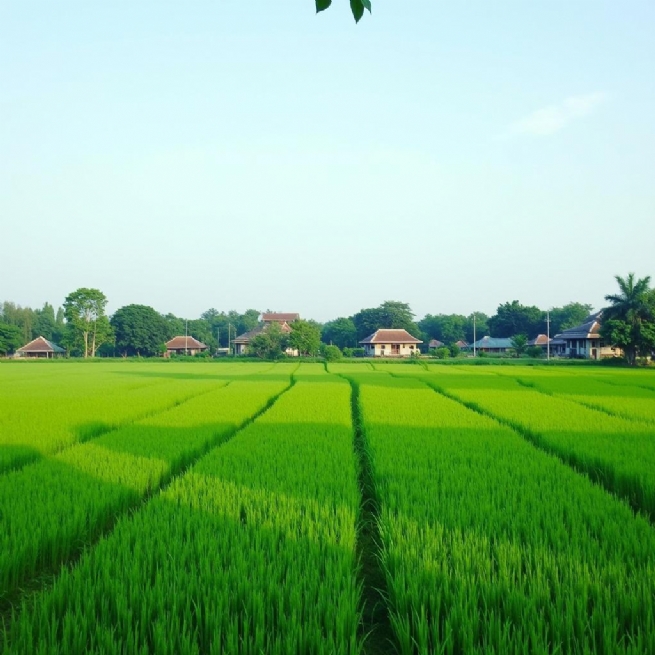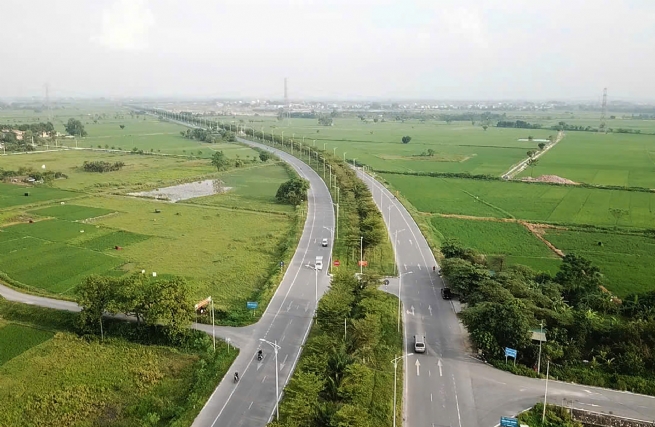Tam Hung commune has significant potential for developing a commodity-based agricultural economy, supporting industries, traditional craft village tourism, and services. Benefiting from its location in the transitional zone between urban and rural areas and its rich historical and cultural traditions, the commune possesses all the conditions to make breakthroughs and become a key economic hub in the southern area of Hanoi.

Building on the foundation of new rural development, Tam Hung commune has chosen ecological agriculture as its core development axis, with VietGAP standards, synchronized mechanization, value chain linkages, and digital transformation as the four levers to enhance growth quality, raise incomes, and protect the rural environment.
Developing chain linkages, improving ecological agriculture
According to Bui Dinh Thai, Chairman of the Tam Hung Commune People’s Committee, the commune has developed a concentrated high-quality rice production area of over 1,000 ha, expanded VietGAP-certified rice cultivation, and converted more than 275 ha to organic farming. The mechanization rate for land preparation has reached 100%, and for harvesting 99%. Mechanization has helped Tam Hung’s agricultural production reduce input costs while improving productivity and product quality.
Alongside changes in the fields, the new rural construction movement continues to deepen, with the commune achieving 100% of the new advanced standards and implementing a new rural model based on the 2021-2025 criteria. Notably, the One Commune One Product (OCOP) Program has been carried out in tandem with digital transformation, and to date, the commune has 11 OCOP products rated and classified from 3 to 4 stars. These results reflect strong organizational capacity in production and mark progress in standardizing and branding rural agricultural products. Since its establishment, Tam Hung has held vast agricultural potential, but its development strategy focuses on ecological agriculture, consistent with the Capital’s planning and orientation. “In Tam Hung, ecological agriculture goes beyond technical innovation - it represents a combination of economics, science, technology, and the environment,” added Mr. Bui Dinh Thai.

At Tam Hung Agricultural Cooperative, the focal point is building the consumption chain for Boi Khe fragrant rice, linking enterprises from production to consumption, including Bao Minh Agricultural Products Processing and Trading Joint Stock Company and Vietnam National Seed Group JSC. Do Van Kien, Director of the cooperative, shared that contracts with businesses help standardize processes, ensure quality control in line with safety standards, and secure stable output, thereby increasing the added value of local rice. When the value chain functions smoothly, the benefits extend not only to farmers but also to supporting services, creating a strong economic foundation for ecological development goals.
The Resolution of the Commune Party Congress for the 2025-2030 term sets clear goals: consolidating high-quality rice cultivation areas in line with food safety and hygiene standards, expanding production models under VietGAP and organic practices, and strengthening links between cooperatives and enterprises to build a stable value chain that enhances the competitiveness of agricultural products. In resource and environmental management, the commune continues to establish and adjust annual land use plans, ensuring transparency in site clearance while mobilizing people to protect the production and living environment. These orientations are framed within a vision of connecting agriculture with tourism and cultural services, aiming to diversify livelihoods and make effective use of indigenous values.
People are the center
The planning goal of Tam Hung places people at the center, with planning serving as a lever for economic, cultural, and social development. “Tam Hung is moving toward a green, smart urban area with high-quality services. The commune is focusing on residential, commercial, and service subdivisions designed under the ‘walking radius’ model, aligned with the Ring Road 4 axis and major connecting routes; developing a network of green parks, regulating lakes, squares, and walking paths; and building synchronized digital infrastructure such as smart lighting, parking management, and public Wi-Fi,” said Bui Dinh Thai, Chairman of the Tam Hung Commune People’s Committee.
In Tam Hung, social infrastructure is defined by the principle of “going first - going together.” The commune plans to add schools at all levels built to higher standards, along with medical stations, cultural and sports facilities, and centralized parking areas; expand and upgrade inter-village roads; increase the coverage of street lighting, clean water, and waste collection; and gradually digitize operational management.

According to Bui Van Sang, Secretary of the Tam Hung Commune Party Committee, to make the planning “come to life,” Tam Hung will implement five main groups of solutions. The first is discipline in planning implementation and digital management: completing the master plan and zoning based on a digital database; publicly and transparently disclosing land use indicators, boundaries, and priority project lists; applying digital platforms to monitor progress and quality; and strictly enforcing the “5 clear” principle in assignment and management. Next, the commune will prioritize framework infrastructure and connected spaces; promote public-private cooperation and attract investment aligned with environmental and social standards; develop a green urban economy with clean services and logistics linked to vocational training; and ensure social security, cultural activities, public spaces, and social consensus.
With strong political determination and methodical steps, Tam Hung has clearly defined that planning must be practical, tied to resources and a specific investment roadmap, with priority “components” identified for each stage (framework infrastructure - core urban areas - ecological agricultural belt - public services), always placing people at the center of benefits and ensuring fair access to basic services. “Alongside planning, Tam Hung is determined to consider public-private cooperation as the ‘engine’ and people as the ‘center of benefits.’ With its affirmed internal strength, clear orientation, and mechanisms to attract capable investors, Tam Hung has the foundation to become a green urban development hub in the Southwest of Hanoi, making a practical contribution to Hanoi’s 2045 goal: modern, civilized, and sustainable,” the commune emphasized.
By Do Ngoc, Vietnam Business Forum
|
This special section is supported by Hanoi Coordination Office of the New Rural Development Program |